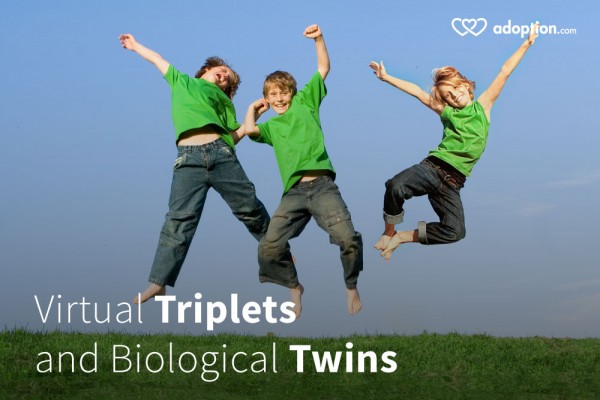One thing that makes my family rather unusual is that among our children we have a set of virtual triplets and a set of biological twins. By virtual triplets, I mean that we have three children, one born to us and two adopted, whose birthdays are within 8 months of each other. But even this doesn’t tell the whole story. Because virtual twinning (not to mention tripletting!) is a rather hotly debated topic in the adoption world, I thought I would share our experience.
When we started the process for our first adoption, we already had five children, the youngest being almost three. When we received a referral, it was for a little boy who was 8 months older than our youngest son. We were not against virtual twinning and accepted the referral. I will be honest, if you were to ask my opinion of virtual twinning in the first year, I’m not sure I would have given it a positive endorsement. Looking back this was due far more to my son’s extremely difficult transition and trauma response than it was to the fact he now had a brother the same age. We were all in crisis mode and it was difficult to think critically and clearly about what we were experiencing.
Another adoption later and we discovered that we were expecting twins. When they arrived, the twin tally was now one set of virtual twins and one set of identical, biological twin girls. It was at this point that my thinking about the whole virtual twin debate changed. Up until the girls were born, I had sort of thought of my boys as being twins. They were nearly the same age, were the same size and could do about the same things. Watching biological twins relate and interact, however, I realized that my boys were no more twins than any other pair of my children. Brothers, yes, but twins, no.
Three years later we brought home another daughter who is only two weeks older than our first adopted son, thus creating virtual triplets. (Confused yet?) I use the term ‘virtual twin [or triplet]’ for its descriptive properties, but I don’t really like it. The use of the word ‘twin’ has connotations that I don’t find fit the relationship that my three children have.
Watching my little girls, I am constantly amazed at the bond and closeness they share. I would say my children as a whole are close as siblings, some of them very close, but none of those relationships come close to what I see in these two little ones. It is not just that they look alike. Their personalities are so vastly different that once you get to know them you are more struck by how different they are rather than how alike. Yet even with these differences they are part of a set… they are twins. It is not something that we impose upon them, but rather a way to describe a relationship that we observe. Before watching it play out before my eyes, I would not have understood. It is an intangible thing that is observable yet difficult to describe. These two girls share a mutual awareness that they are a part of each other in ways that transcend the normal sibling bond.
This does not describe the relationship between the other three age mates in the family. They are brothers and sisters who are very different people that just happen to be the same age. There is not the same type of connection there that we see present with our actual twins. The biological twins have always been together, the virtual triplets have not.
So my point in sharing all of this with you? I think we need to think of adopted children who are close in age as something other than twins. The word twin has a whole host of connotations. It implies closeness, alikeness, similarity. That is a lot of baggage to dump on two children whose birthdays fall close to each other. I also believe if we would just refer to them as brothers and sisters, a lot of the negativity involved virtual twinning would be lost. We don’t have any trouble with creating brothers and sisters, and that is all that is happening when two children have birthdays which are close together. We are not creating twins, because we can’t.
I also think a change in terms would help parents as they navigate how to integrate this new child into their family. By thinking in terms of twins, there is more likelihood of treating the pair as a group rather than as individuals. There is also the chance that we may communicate a tacit expectation of closeness between new siblings. We should be careful not to force a relationship that needs time to grow, and perhaps do damage to that relationship before it has had a chance to mature.
Like so many things, the success of adopting children close in age depends on many factors. However, I believe that we make a mistake if we assume that adoptions that bring together siblings of similar age are inherently problematic. The first step towards a positive relationship between two children close in age would be a realization that while they are siblings, they are not twins and we do not need to saddle them with the twin label. As in so many things, the language we use to describe this sibling relationship matters in setting expectations and creating possibilities.

